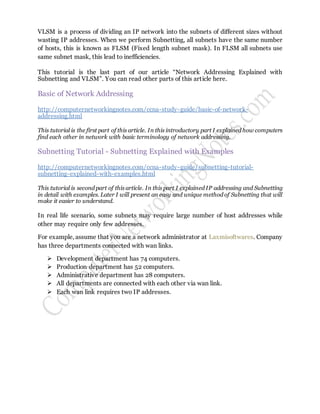VLSM (Variable Length Subnet Mask) allows efficient allocation of IP addresses by using subnets of different sizes based on network needs. This example shows how VLSM can fulfill the address requirements of different departments within a company using a single Class C IP address, whereas FLSM (Fixed Length Subnet Mask) would waste many addresses. The tutorial outlines the steps to perform VLSM subnetting to allocate specific subnet sizes and addresses to each department and network based on their requirements in a way that minimizes wasted addresses.




![Subnet Sub 1 Sub 2 Sub 3 Sub 4 Sub 5 Sub 6 Sub 7 Sub 8
Net ID 0 32 64 96 128 160 192 224
First
Host
1 33 65 95 129 161 193 225
Last
Host
30 62 94 126 158 190 222 254
Broad-
cast ID
31 63 95 127 159 191 223 255
Subnets 1 to 6 [address from 0 to 191] are already occupied by previous segments. We
can assign subnet 7 to this segment.
Segment Administrative
Requirement 28
CIDR /27
Subnet mask 255.255.255.224
Network ID 192.168.1.192
First hosts 192.168.1.193
Last hosts 192.168.1.222
Broadcast ID 192.168.1.223
Step 6 :- Our last three segments require 2 hosts per subnet. Do subnetting for these.
192.168.1.0/30
Valid subnets are:-
0,4,8,12,16,20,24,28,32,36,40,44,48,52,56,60,64,68,72,76,80,84,88,92,96,100,104,108,
112,116,120,124,128,132,136,140,144,148,152,156,160,164,168,172,176,180,184,188,192,1
96,200,204,208,212,216,220,224,228,232,236,240,244,248,252,256
From these subnets, subnet 1 to subnet 56 ( Address from 0 - 220) are already assigned
to previous segments. We can use 224,228, and 232 for wan links.
Subnet Subnet 57 Subnet 58 Subnet 59
Network ID 224 228 232
First host 225 229 233
Last host 226 230 234
Broadcast ID 227 231 235
Assign these subnets to wan links.](https://image.slidesharecdn.com/vlsm-170617175046/85/Vlsm-5-320.jpg)


